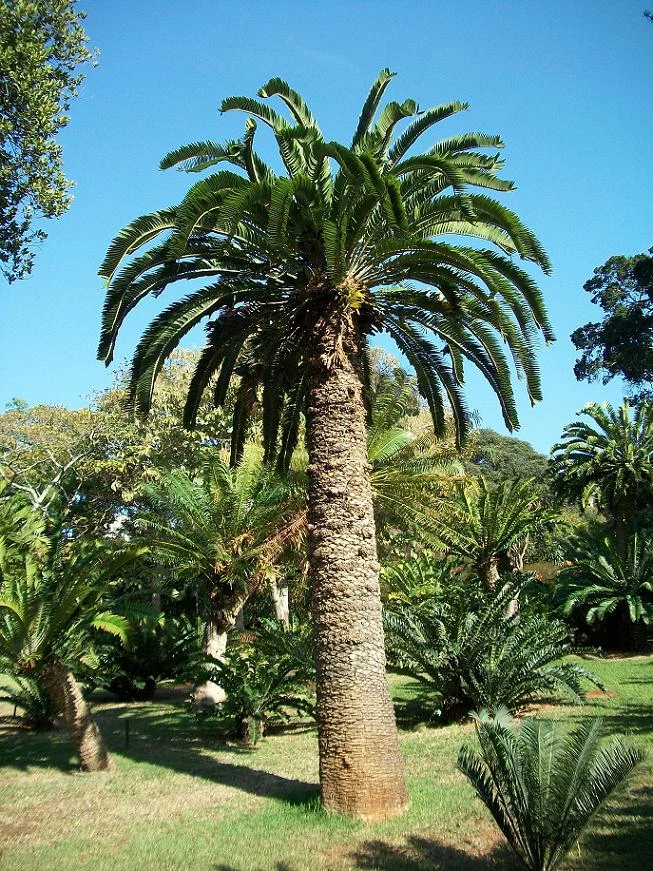Encephalardos woody It is not a small plant and cannot be easily missed. The cycad, found in South Africa, is 6 meters tall and has a trunk half a meter in diameter. A green crown of up to 150 leaves grows from the top of the stem. In a word – this is a piece of wood.
But despite the efforts of scientists, since John Wood, curator of the Durban Botanical Gardens (from whose name the plant inherited the second half of its Latin name), in 1895, scientists discovered the first person of this plant. No other model has ever been found. This is a problem because, like the palm, E. woodii is dioecious – individual plants are either male or female. Male is the only known individual. We are missing “women”.
Research on the only known individual of this species has yielded surprising results. Although this plant resembles modern palm trees, it is actually very ancient. Cycads are the oldest group of plants alive today. They are often called “living fossils” because of their extremely long evolutionary history.
These plants did not outlive the dinosaurs, but may have survived several major extinction events. They were once widespread, Grown almost all over the world. Today, only the last vestiges of their former glory remain.
Cycads are thought to have originated during the Carboniferous period, about 300 million years ago. During the Mesozoic Era (250-66 million years ago), these plants were ubiquitous and thrived in hot, humid climates. Although they resemble ferns or palms, cycads are not related. Cycads are a group of gymnosperms that include conifers and ginkgo trees. Unlike flowering plants (angiosperms) Cycads reproduce using cones.
Loneliest plant in the world
At first glance, it seems that E. woodii cannot be called a “solitary” plant, for example, visitors to London’s Kew Botanical Garden can appreciate that the South African plant is completely solitary and, despite dozens or hundreds of individuals, it is on the verge of extinction.
The only known wild E. woodii was discovered in 1895 during a botanical expedition to Ngoye Forest. South Africa. Investigators searched the area but did not find any other people. Over the next few decades, botanists removed the stems and branches and planted them in gardens. Eventually, the only known wild tree was moved to a conservation plot in Pretoria in 1916. Henceforth, as far as we know, The plant is extinct in the wild.
Since then, individuals of this plant began to appear all over the world. But despite this, E. woodii is on the verge of extinction. Why? Because all individuals are actually clones of the first model found in nature. As a female of this species has never been found, natural reproduction by ancient wood is unlikely.
All extant specimens of E. woodii s are trueare clones Their potential for genetic variation in resistance to environmental change and disease is limited. We know many examples of plants that have died under similar circumstances from a deadly infection. A single germ can wipe out an entire species due to lack of genetic diversity.
An example of such a disaster was the Great Famine that struck Ireland in the 1840s, when potatoes, a staple of the island’s diet, were hit by a disease that quickly destroyed the crop. The genetic uniformity of potatoes grown in Ireland… The disease quickly spread to all the plantations on the island.

E. woodiiWikimedia
A similar phenomenon led to the extinction of bananas in the 20th century, and may once again bring down the entire industry related to their production and processing. In the 1950s, this disease destroyed the Gros Michel variety of bananas, which were dominant. In their place, in most cases, banana trees of the Cavendish variety were planted – the most popular variety in the world today. But both Gros Michael and Cavendish banana trees are clones of an original individual, meaning that all individuals in the world are equally susceptible to the disease.
To save E. woodii from this fate, scientists pFinally cheating on your partner (and lives in the form of hundreds of clones) male representative of the species. Finding a female means the cycad is no longer on the brink of extinction and can recover, as sexual reproduction introduces genetic diversity and represents a breakthrough in conservation efforts.
The researchers decided to search for the female of the species using satellites, drones and aerial photographs. The research, conducted in 2022 and 2025, covers 195 acres, or 148 football fields. Thousands of photographs taken by drones allowed for detailed maps of the surveyed area. Unfortunately, the plant they were looking for was not there. But researchers They will not lose hopeBecause the Ngoye forest, where the only specimen of the plant was found, covers an area of about 10,000 acres.
Artificial intelligence can help search such a large area. Scientists trained a computer to recognize members of the species in aerial photographs. We have female E. Lacking photographs of Woody, the researchers used synthetic images, which use our knowledge of related plants to create images of hypothetical members of the species.
Diseases are not the only threat to its survival. The fact that this plant is so rare makes it a very valuable spoil for plant people Predators. Rare cycads fetch prices starting at $600 per centimeter of plant height. Some models fetch millions of dollars.
What are cucumbers talking about? Polish scientists are studying thisBolsad news

. “Hardcore internet junkie. Award-winning bacon ninja. Social media trailblazer. Subtly charming pop culture advocate. Falls down a lot.”
